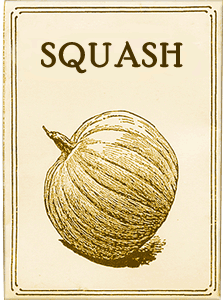SQUASH
Vitals
• Cucurbita , belonging to the squash and melon family, Cucurbitaceae.
• Origin: The Americas.
• Early cultivation: 10,000 BC.
• Early archeological evidence: In Florida, seeds and rinds from C. pepo (the species which includes summer squashes and zucchini) have been found that date back to 10,000 BC.
• Evidence of other early cultivation: Larger seeds and thicker rinds indicate that cultivation was well under way in Mexico from about 7500 and 5500 BC and in the Mississippi Valley of the United States in 3000 BC.
• Climate: Warm temperatures (70–90 °F; 20–30 °C)
• Major producing countries: China, India, Ukraine.
Short historySquashes are more American than apple pie. So American, in fact, that they weren’t known outside the American continents until the late 1400s. Archeological remains of squash have been found all over the United States, Central America, and South America. The flesh of wild and early cultivated squashes was bitter; the plants were grown largely to harvest their seeds and use the fruits as storage vessels. Native Americans grew squash plants in plots together with corn and beans, and the three protected each other from weeds and pests. Together, the three also provided a balanced diet. There are five distinct species of squash, indicating that Native Americans probably domesticated the wild squash five times. Today, four species are grown commercially, and they provide us with a huge variety of vegetables in a rainbow of colors, sizes, and flavors.
Squash facts and loreNative Americans probably began cultivating squashes in order to make bigger and sturdier storage vessels. A side benefit was that as the walls of the fruit became thicker and stronger, they became tastier as well.
Giant pumpkins , one kind of squash, can grow to a weight of over 1,200 pounds (545 kg). Pumpkins of lesser size but of this same species, C. maxima , have been grown in Peru since 2000 BC.
The filling in most pumpkin pies is actually a variety of sweet squash that has a much richer and more nutritious flesh than that of a pumpkin.
The word squash comes from the Native American Naraganset word askutasquash, which means “eaten raw.”
Saving the seed
Squash is one of the easiest vegetables to save seeds from, though if you’re growing pumpkins, it can be hard to resist eating all the delicious seeds! The easy way is to set aside a handful before you roast them.
You can grow more than one species of squash at a time, but different varieties of the same species are likely to cross-pollinate. Experienced growers can control reproduction with hand-pollination, but beginners should consider planting only one variety of the same species.
• Let the squash fully mature on the vine before harvesting. The shell of summer squashes should be hardened.
• Let the squash sit, uncut, to cure for four to eight weeks. This will add vigor to the seeds.
• Cut open the fruit and scoop out the seeds. Rinse them in warm water. Discard nonviable seeds that are flat (good seeds are plump).
• Dry the seeds with a towel and spread them on a board or cookie sheet to dry for a couple of weeks.
• Store them in a sealed container in a cool, dry place away from light until you are ready to plant them. Squash seeds are viable for about four years.
Saving and planting seeds is easy. Make sure that the plants you are saving seed from are what’s called an “open-pollinating” rather than a hybrid variety. For a list of companies that sell seeds for open-pollinating plants see our article Why Save Seeds?
